“We shipped brooms to Macy’s in New York for years . . . It would kind of pride you a little bit to ship to Schwartz’s in Cincinnati or Macy’s in New York.”
Jim Shaffer’s shop is dusty and smells like a horse stable—a comforting olfactory association that I suddenly realize has less to do with horses than with the rolled and bundled straw I see stacked high along the walls. Though the pole barn that houses Shaffer’s Charleston Broom and Mop Company is just a few miles from the capital city of Charleston, West Virginia, the unincorporated area where it sits along Davis Creek in Loudendale is a wooded, quiet, and close-knit community. Everyone who lives here knows Jim, and many people across the state know him too. At 87, Shaffer has been making brooms for seventy years and is the last handmade commercial broom maker in West Virginia.
Jim places a dowel in a drill chuck and grabs a handful of straw. He’s done this for so long he doesn’t need to measure—he can build a broom by feel. With his weathered hands, he adeptly adds six more handfuls around the dowel as he rotates it via a foot pedal. A wire feeding through the drill chuck binds the straw to the dowel, arranging it circularly, like a cartoon witch’s broom.
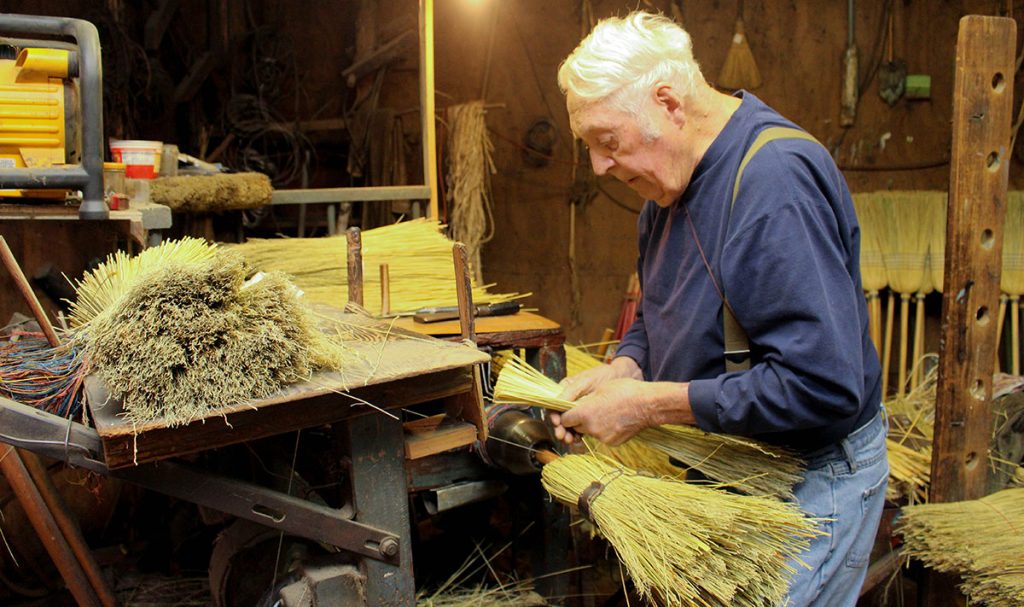
Jim has easily made a million brooms in his lifetime.
Broom in hand, Jim walks the four steps over to a large stand-up sewing machine by a row of long windows. Jim’s machine was manufactured in Baltimore, Maryland, and is older than him, but broom-making equipment like this is not made in the United States anymore, only in China. A vice in the sewing machine spreads and flattens the straw, and with another foot pedal, Jim laces five bands of red thread through it. Morning light streams through the windows onto Jim’s work, illuminating flecks of broom corn floating in the air around him. Loud rhythmic noises emanate as the needle weaves through the straw, drowning out Jim’s explanations, but the process is so physical, it doesn’t need to be narrated. Jim considers these five bands of sewing a mark of quality, as they serve to fasten the straw to the broom, ensuring durability. He doesn’t approve of a broom with fewer than five bands, not to mention a synthetic broom. After he cuts the straw to make it uniform and runs it through a machine to remove any loose pieces, Jim stamps the stick end on the ground, and it’s done—mine to take home.
The whole process takes just a few minutes, but Jim estimates he repeats these steps 250 times per week. In the early days, when he was working in a factory with other broom makers, that number was more like 300. But even at 250 per week, over seventy years, that amounts to an astonishing 873,600 brooms. Jim has easily made a million brooms in his lifetime. That’s a million brooms that have been held by over a million pairs of hands—housewives, and husbands, and janitors, and kids doing their daily chores. A million brooms that have become everyday objects in a million households, a million broom closets, a million kitchen corners, and featured in at least a few witch ensembles and Harry Potter costumes and used as ad hoc hockey sticks, limbo bars, and wedding hurdles—all since the year that seventeen-year-old Jim Shaffer heard the daily news report that fellow West Virginian Chuck Yeager had broken the sound barrier in his Bell X-1, on October 14, 1947.
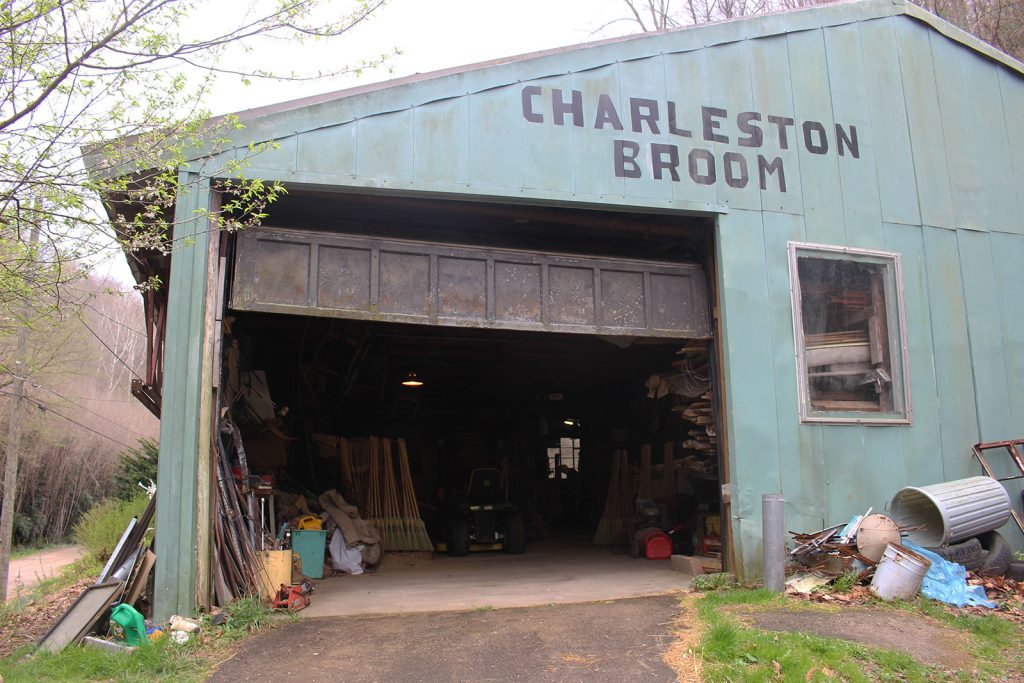
That’s a million brooms that have been held by over a million pairs of hands—housewives, and husbands, and janitors, and kids doing their daily chores.
I don’t intend to romanticize Jim’s labor—he certainly doesn’t. But there is something remarkable in his endurance and longevity in his trade. While the industry and infrastructure has changed around him, his process has remained the same, with minimal adaptation. But even those families who have bought brooms from him for generations understand that his seventy-year (and growing) career amounts to a methodically profound life of work, a meditative and connective practice, and a durational performance that evolves only because its context does.
Editor’s note: In a recent phone call, Mr. Shaffer regretted to share that he’s no longer able to keep up with demand and has stopped making brooms. We are proud to publish his story, and grateful to our friends at the West Virginia Folklife Program for sharing it with us. Learn more >
James Shaffer
October 17, 2016
Loudendale, West Virginia
James Shaffer: I’m James Shaffer, most people call me Jim. I’m 87 years old, and I’m the owner of Charleston Broom and Mop Company here in Loudendale, only 1 mile short of Kanawha State Forest.
Emily Hilliard: How did you get into broom making?
JS: Well, I had quit school and there was a couple other boys lived in the neighborhood that was already working over there, and they told me there was an opening. So I went over and went to work. And stuck with it. (laughs)
EH: Could you talk about that first day on the job?
JS: The first day on the job, I went in and talked to the owner or the boss and he told me that he had supposedly had an experienced man coming in to operate the sewing machine that I was interviewing for. But he said they had two of the sewing machines, his brother was operating one of them—of course, the other one was vacant. And he told me, he says, “Go up there and watch Mack sew some brooms and see what you think of the job.”
So I went up there and watched his brother sew a few brooms and told him what had transpired between me and his brother, and he said, “Well, come on by here at this other machine, and I’ll show you.” So I stayed there and tried to learn to sew the brooms for maybe an hour or an hour and a half, and his brother, the boss, come up and says, “Oh, what do you think about it?” And I says, “Well, it’s a job! It’s alright with . . . good with me.” And I says, “Do you want me to go ahead and run the machine? Or do you want me to come back tomorrow or sometime?” And he said, “Well, you’re here, you just go ahead and stay.” So that was the hiring of the job. So I’ve been there ever since.
EH: How many people were working there?
JS: It was about eighteen or twenty of us that were working there at that time. Of course, it was a lot of difference in the straw—you had to have as many people sorting and separating the straw, getting it ready for making brooms as you did people actually making the brooms itself. So, we had anywhere from three to four broom makers, who was actually assembling and strawing of the handle, and my job was to flatten the broom out and sew it to where it would be a flat broom. It was basically a round broom when they finished with it.
EH: At that time, about how many brooms would you make per day, and where would you send them?
JS: Well, we basically would make up to 300 dozen a week, which is basically a tractor-trailer load per week. [We sent them] all over the Eastern United States—Ohio, Kentucky, New York. We shipped probably half of what we made to other states. Pennsylvania somewhat, and New York, even up in Connecticut. We shipped brooms to Macy’s in New York for years, as well as a couple other large department stores. That was during the war years when you could sell any brooms you could make pretty much. It would kind of pride you a little bit to ship to Schwartz’s in Cincinnati or Macy’s in New York.
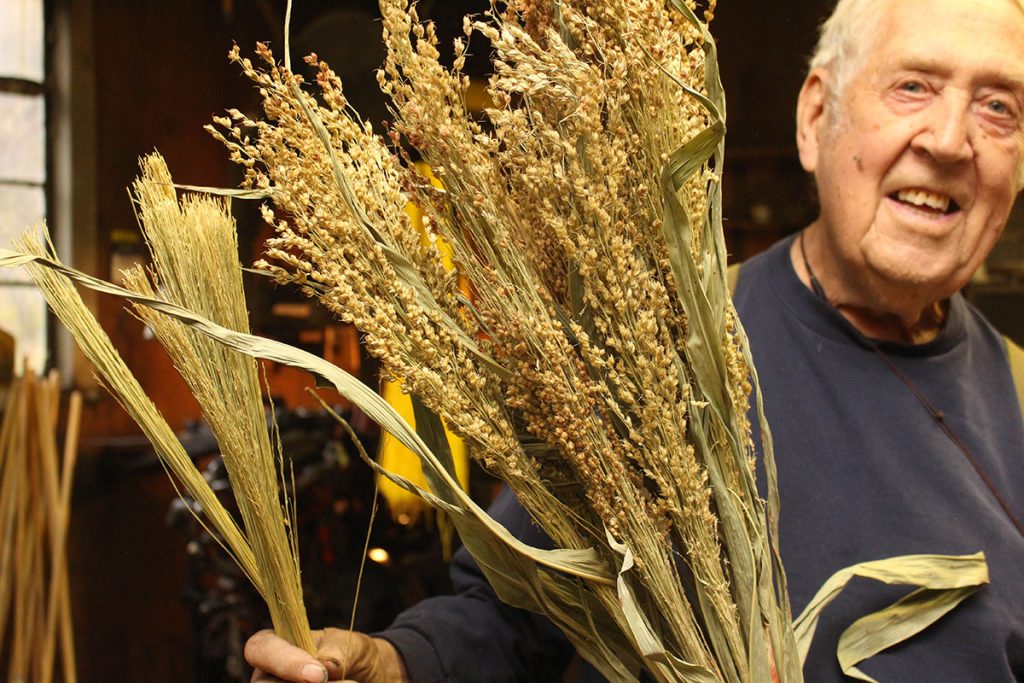
“It would kind of pride you a little bit to ship to Schwartz’s in Cincinnati or Macy’s in New York.”
—Jim Shaffer
EH: How have you seen that change?
JS: Well, the change has been in the usage of brooms—straw brooms, of course they have so many, instead of sweeping sidewalks and outside garage areas and everything, they use the gasoline blowers now to blow the dirt and dust away. Same thing in the house with these new laminate floors they have, they’re so slick that they’ve developed dust mop–type things for those sweeping the house. So the broom industry is fading out. I suspect in another five to seven years you won’t find a straw broom in the store.
EH: How do you feel about that?
JS: Well, that’s just a natural occurrence. If you can find something better, they’re gonna go do it—I have no objections to it. If it wasn’t for Lions Clubs selling brooms as their fundraisers, I wouldn’t have a business today. You know back twenty, thirty years ago, or farther back, we didn’t sell hardly any Lions Clubs—it was all wholesale distributors. But Walmart, Kmart, and Kroger’s have took all that over now, and you don’t have any mom-and-pop stores to buy from the wholesale distributors, so they all went out of business.
EH: Could you tell me how you started your shop here?
JS: Well, back in ’86—of course I had always planned on starting a shop up of my own. But I’d stayed with the company over there ’cause they owned the real estate where they were, and they were trying to sell the real estate. And, as you know, to sell an empty vacant building is not too good pricewise, so I stayed with them to help them sell their business, which they never did.
And in ’86 I had a slight heart attack, and it kind of scared the people that owned it at that time—of course, they never did have anything to do with operating the factory per se—that was always left up to me. I run it just like I owned it for ten to fifteen years. But they got afraid that my heart attack would do me in as far as working was concerned, so they decided to close up all they could. At the same time, I’d already built this building for this purpose on a deal. So I was well prepared—I didn’t miss a day from the time they stopped over there I had my machinery and everything over here and was set up and ready to go.
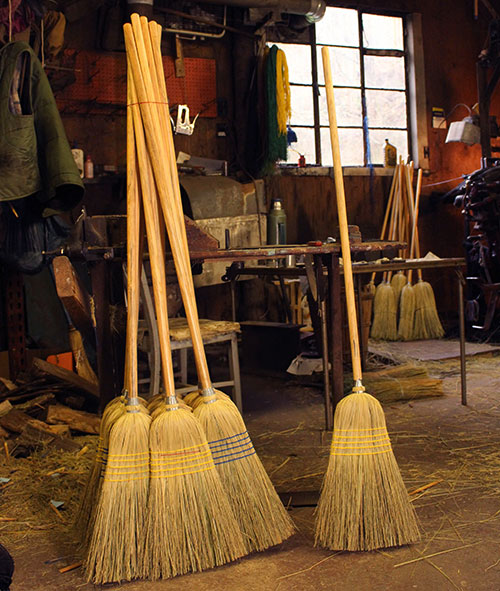
EH: So at that time you were the only employee at the other shop?
JS: No, there was three other employees. I worked the other two of them for a while out here, but business dropped off enough that I didn’t need them—I just worked them part-time. And was lucky enough to have somebody experienced that I could call on—wish I had them now! (laughs)
EH: What is going to happen to the shop?
JS: Well, when I finally give up on it, I guess it’ll just die. I don’t know, a lot of people at the Lions Clubs kind of worry about it. Some of them have even considered trying to run it on their own, but nobody’s come up. It’s just not a profitable enough business to stay in unless you’re in my position or Roosevelt’s sending you that Roosevelt check every month—social security. (laughs) That’s your living, and this is spending money here.
EH: Have you taught any apprentices over the years?
JS: I’ve taught a lot of people to do the job or make brooms but none of them have ever stuck with it.
EH: Could you tell me what makes a good broom?
JS: It’s the quality of the straw that you use and, of course, placing it in there at the right part. The tip of the straw is the very best of sweeping quality, and a lot of people cut the ends after they make a broom. We do too but I cut very little of it off because the least you cut off the end of it, the better it sweeps.
EH: When you go to a store, do you look at their brooms and size them up?
JS: Every one. I take one down and inspect it close for a lot of different parts—to see where it came from, who made it, and how they made it, what they made it out of. When I go into a store, I always check the broom rack to see what broom they have in the rack and the quality of it, the quality of the straw they’re using in it, as well as the price and everything.
EH: How does a synthetic broom compare to one of your brooms?
JS: The synthetics, plastics or all doesn’t compare to a natural corn broom at all. The sweeping quality of it.
EH: It just doesn’t pick up as much?
JS: It just doesn’t pick up as much, right. You have to sweep the same spot four or five times to move the dirt or dust, whatever it might be, as you do with a corn broom.
EH: And why is five bands the standard?
JS: I really don’t know why five bands is standard—it was that way when I got here! (laughs) But it really depends on the size of the broom, and more than the five bands of sewing on it, it’s the number of stitches that’s in each band. A lot of places will only put seven to nine stitches in each band, and I always put anywhere from nine to twelve in each band. But it keeps it from falling apart as you’re using it and flexing it.
EH: So you look down on a 3-band broom?
JS: Well, sure! Whatever product you’re into, anybody else don’t come up to your standards, you don’t approve of it! And I’ve always been one that didn’t think I should go and make that cheaper built item. I always depended on quality and word of mouth for advertising.
EH: Could you tell me about the different types of brooms that you make?
JS: Well, I make small whisk brooms for sweeping cars and even machinery—a lot of machine places use the hand whisk brooms to sweep their machinery off and then we make toy brooms for children. You see a lot of them more so now in restaurants, ’cause they go along with a little toy broom and dustpan to pick up stuff during the day. Then, as I say, we make a few light-weight, or what we call medium-weight, brooms for the elderly, and then your regular household broom, and then the heavy duty. I do make a few extra heavy duty for roofing companies that sweep the gravel on the roofs. They sweep and spread the gravel with a broom that’s real heavy. Heavy-duty straw.
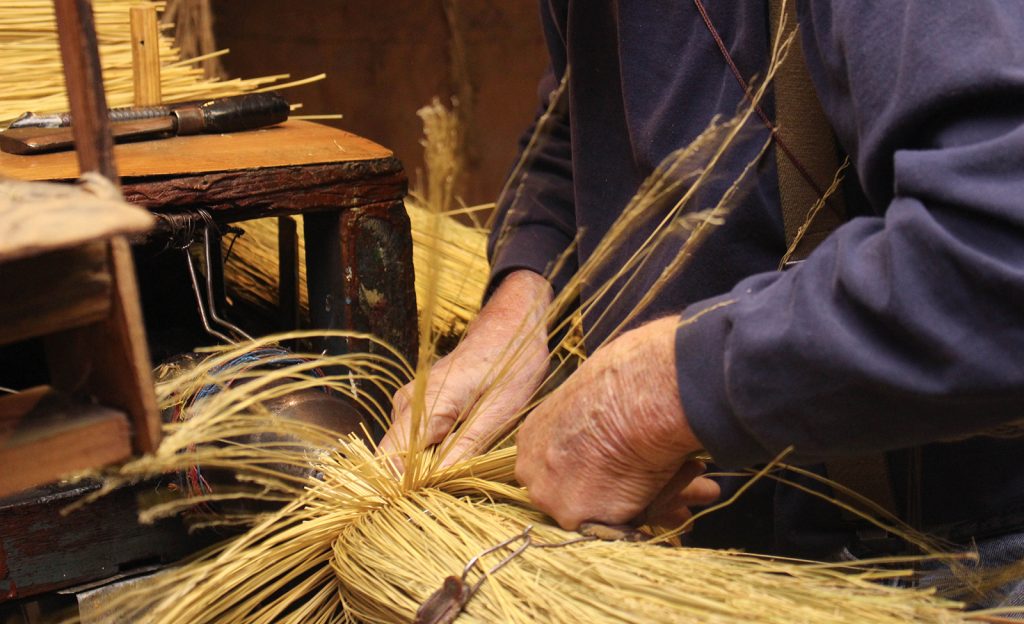
EH: Who have you made brooms for? Have you made them for special occasions?
JS: Yes, I’ve made them for about every kind of special event that you can. I’ll probably in the next week or two get an order for witches’ brooms, which I’ve made a few before. I don’t make them per se and try to go out and sell them—I don’t do anything that way. I wait ’til the customer comes to me and requests something or other.
EH: Are there changes in where you source your materials?
JS: Yes, big changes there. (laughs) I have to keep hunting for outlier places to buy. Today there are only two places in the U.S. to buy broom straw—you can buy handles a lot of different places, but the straw I either have to get it out of South Carolina or San Antonio, Texas. Used to get it a lot of places: Pittsburgh, Cincinnati, Columbus, Greensboro, North Carolina, even back further Kansas and Oklahoma. But since all the growing of the straw now went to Mexico… and the less brooms made and the less straw, the less places that are probably enough to stay in the business.
EH: Could you walk me through a typical day here?
JS: Well, a typical day, you just come in and look around and see what you need and which broom or which mop, or whatever you need, you decide from what orders you got and what stock you got, you decide what size you want, what product you want to produce that day. So, you know, whether you’re working with a little short broom or a household broom or a heavy duty, you have to gather up the straw and the handles to match that and go to the tying machine then and start tying them.
If I’ve got an order for 3 or 4 dozen that I need, I’ll tie that many, or if I’ve got it for 10 dozen, I’ll tie that many brooms onto the handle with the wire, and then when I get that quantity made up, I’ll go to the sewing machine, then press them out flat and sew and finish them up, bundle and package them to go out.
EH: What’s the highlight of your day?
JS: I don’t have a highlight of my day—every day is the same. I get up and get my breakfast and come to work and do whatever I need to do. It’s all in a day’s work, as they say.
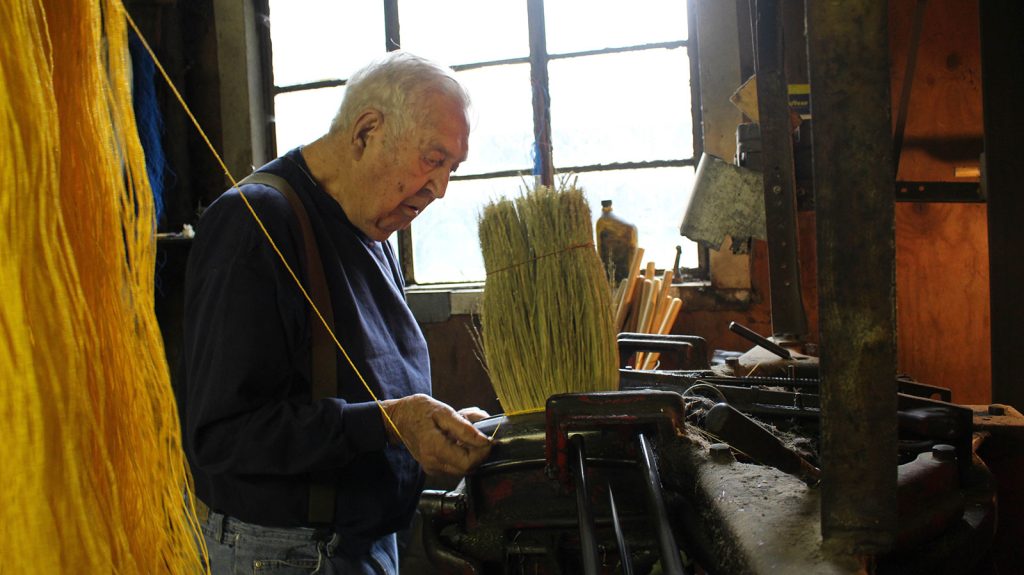
EH: What keeps you doing it?
JS: Well, you gotta have something to do! And you know I feel great all day every day, so I have to do something. If I wasn’t here making brooms, I’d maybe be over at McDonalds making hamburgers or something. I mean, you need to keep yourself occupied and busy if you’re able to, and thank goodness I’ve been able to pretty much all my life.
EH: So I noticed this picture on your wall that says “NRACode Broom Industry.” Could you tell me what that is?
JS: That was the original regular working regulations, setting wages, setting how many hours you could work or where overtime started if you’re working excessive hours. And setting the minimum wage. That was done back under Roosevelt—have to mention him again. (laughs)
EH: Are you a Roosevelt fan?
JS: Kind of, yeah! (laughs)
EH: And why is that?
JS: Well, I don’t know, he did a lot of good things. I don’t think anybody could ever do any more for the elderly people—he allowed us to get old by having it so we could slow down and not work as hard in our later years. Most people go ahead and quit at 65 or 70, I just never was in a position I felt like I wanted to do that. Franklin D. Roosevelt, as far as I’m concerned, was the best leader and will always be the best leader that the country’s ever had.
EH: What do you listen to while you work?
JS: Country music! Country and Western.
EH: And do you have a favorite artist?
JS: No favorite artist, just the older the better. Match my own time of growing up.
EH: Are there other broom makers in the state of West Virginia?
JS: Well, I’m the only commercial broom maker making commercial brooms in the state. There’s a few that make some craft brooms for wall hangings and things of that type. But all the other shops have given up. There used to be four or five shops here in the Kanawha Valley that made brooms to sell. We were always the largest of them, but there was one on the west side, one in Nitro, one on South Ruffner. There was another one or two in the state. Clarksburg had a pretty good-sized one at one time, but they’ve been gone for twenty years or more probably. They finally went bankrupt. You either go bankrupt or you just off and quit. (laughs) There’s not enough profit there to stay.
EH: I know you do it in stages, but how fast can you make one broom, would you say?
JS: Basically, for one broom in just normal work—I don’t mean trying to break a record of making one broom—but probably eight to ten minutes.
EH: So how many do you make in a day?
JS: Well, I make probably thirty, thirty-five. Up until the last three or four years, I’d make fifty a day. But time changes everything, whether you realize it or not.
EH: And I noticed your lunch box—what do you eat for lunch?
JS: I bring whatever we had yesterday for dinner. That’s my lunch. I don’t bring sandwiches. I don’t average bringing a sandwich once a month. It’s always beans and potatoes or meatloaf, I think’s what I got today, so. And fruit—I eat more fruit than I do anything else. I eat at least three to maybe four fruits per day.
EH: That’s your secret!
JS: Well, I don’t know whether it’s a secret or not, but it works! It works for me!

EH: Do you have advice to a young person who is interested in broom making?
JS: Yeah, don’t do it! (laughs) There’s nothing wrong with it, but you got to have an income other than your broom making, you just use it as a substitute for spending money or something like that. You know, unless you work for other people, you can’t manufacture brooms one on one and sell them and make a living. You have to have other people working for you and you make part of your living off of them and whatever you can manage to make and work on your own.
EH: What do you find yourself thinking about when you’re making brooms every day?
JS: Everything. Just the world situation, maybe what I might get into this weekend. There’s just nothing in particular that runs through your mind day in, day out. It’s just a general lifestyle that you live and what you might do.
EH: Well, is there anything you’d like to add?
JS: Well, not really, just the fact that I appreciate the Lions Clubs and anyone else actually that stops by—only downfall I have of making brooms here is, being here by yourself all the time. Sometimes I’ll go a week without somebody walking through the door, but it really doesn’t bother me a whole lot, but I do enjoy company.
EH: What are your hours?
JS: I’m open now from about nine o’clock in the morning to about 4:30 or four o’clock of the evening, and I work Monday through Friday. I try to take Saturdays off just to loaf with the family.
EH: Do you have anything else you’d like to share?
JS: Not that I can think of.
EH: Alright!
JS: That’s not unusual. (laughs, points to head) It don’t think as good as it did.
EH: Well, thank you very much.
JS: You’re quite welcome.
Emily Hilliard is the West Virginia state folklorist and founder of the West Virginia Folklife Program at the West Virginia Humanities Council. She holds an MA in Folklore from the University of North Carolina at Chapel Hill. Her work has been published by Ecotone, The Bitter Southerner, NPR, and the Southern Foodways Alliance, among others. Find more at emilyehilliard.com.


